Networking and Security Content Analysis Report for ITECH1102 Course
VerifiedAdded on 2022/10/19
|10
|2673
|349
Report
AI Summary
This report provides a detailed content analysis of networking and security concepts, covering topics such as the role and function of network connectivity, principles of communication in networks, the role of hardware and software entities, network communication protocols, fundamental aspects of cloud computing, and networking needs for businesses based on network architecture. The report explores various network types, including LAN, WAN, and WLAN, and delves into the importance of network connectivity for error detection, resource sharing, and data protection. It examines network architecture, including peer-to-peer and client-server models, and discusses the significance of network topology and internet connectivity in communication. The report also covers hardware and software components contributing to network communication, various network protocols, and fundamental aspects of cloud computing like unlimited storage, rapid elasticity, and on-demand self-service. Finally, it analyzes networking needs for businesses, including resource sharing, file sharing, internet access, and security, highlighting how these needs are met through different network architectures and technologies. The assignment is designed to help students gain a good understanding of theoretical and practical material and prepare for tests and examinations.

[Draw your reader in with an engaging
abstract. It is typically a short summary of
the document. When you’re ready to add
your content, just click here and start
typing.]
[Document title]
[Document subtitle]
USER
abstract. It is typically a short summary of
the document. When you’re ready to add
your content, just click here and start
typing.]
[Document title]
[Document subtitle]
USER
Paraphrase This Document
Need a fresh take? Get an instant paraphrase of this document with our AI Paraphraser

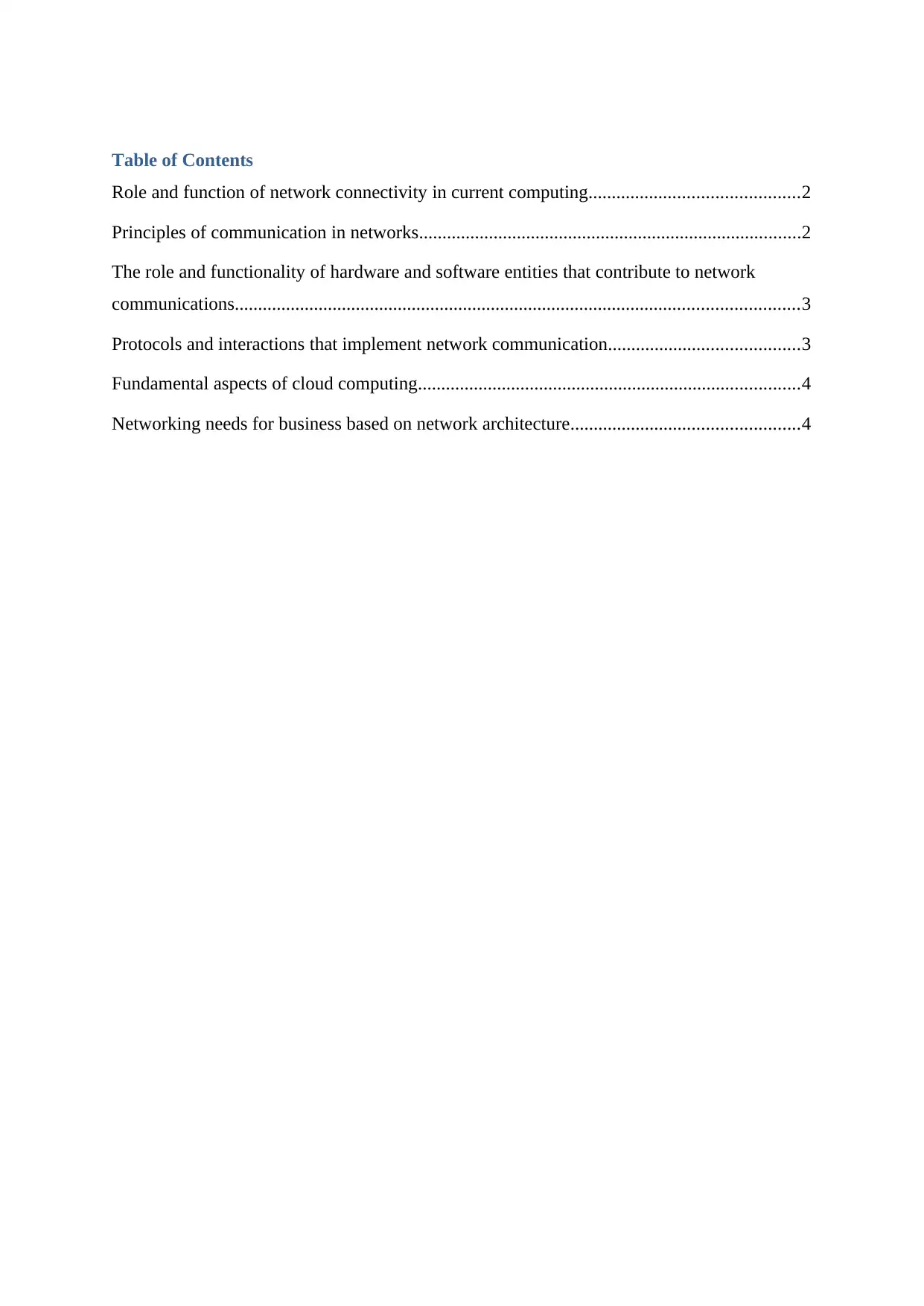
Table of Contents
Role and function of network connectivity in current computing.............................................2
Principles of communication in networks..................................................................................2
The role and functionality of hardware and software entities that contribute to network
communications.........................................................................................................................3
Protocols and interactions that implement network communication.........................................3
Fundamental aspects of cloud computing..................................................................................4
Networking needs for business based on network architecture.................................................4
Role and function of network connectivity in current computing.............................................2
Principles of communication in networks..................................................................................2
The role and functionality of hardware and software entities that contribute to network
communications.........................................................................................................................3
Protocols and interactions that implement network communication.........................................3
Fundamental aspects of cloud computing..................................................................................4
Networking needs for business based on network architecture.................................................4
⊘ This is a preview!⊘
Do you want full access?
Subscribe today to unlock all pages.

Trusted by 1+ million students worldwide
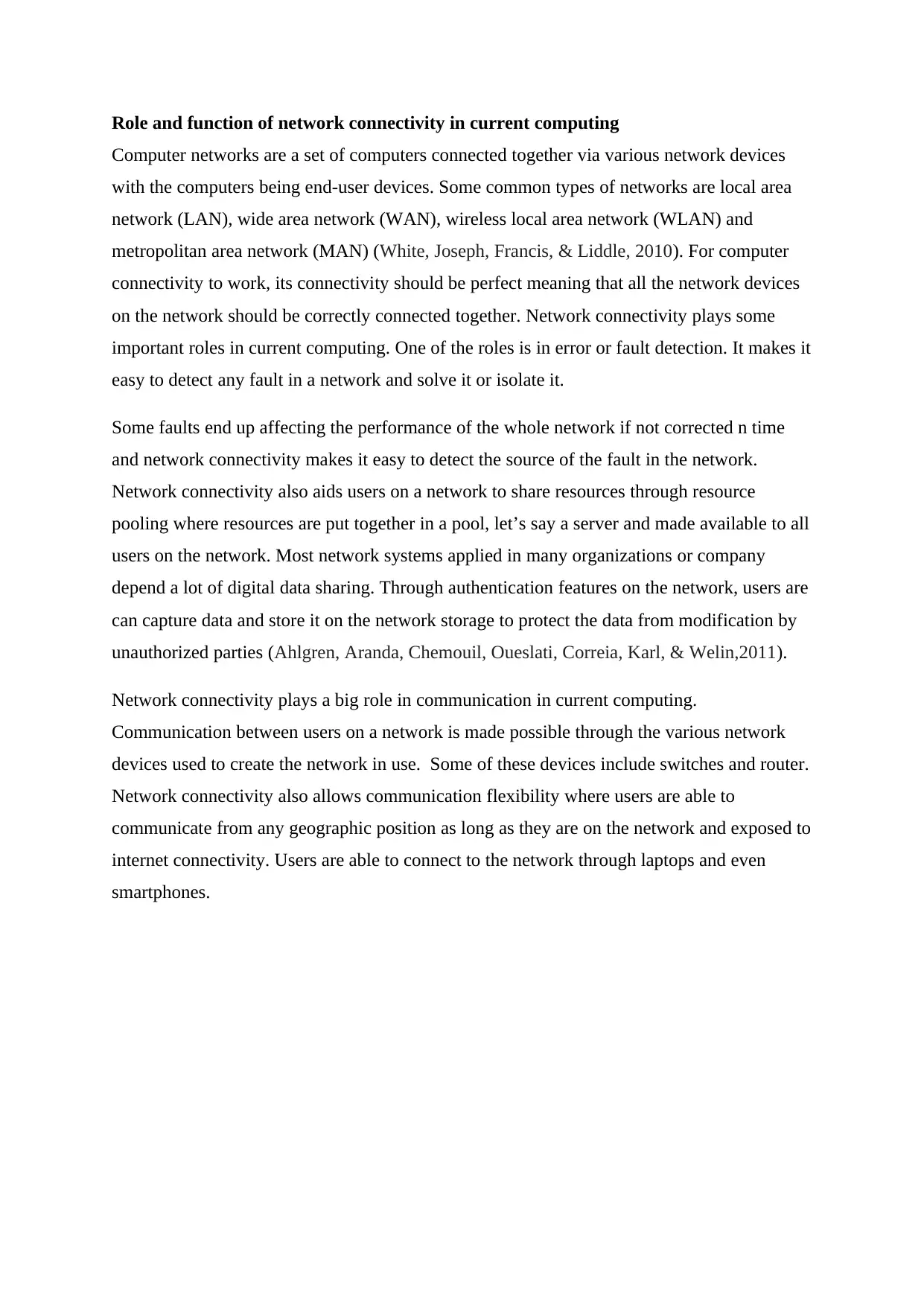
Role and function of network connectivity in current computing
Computer networks are a set of computers connected together via various network devices
with the computers being end-user devices. Some common types of networks are local area
network (LAN), wide area network (WAN), wireless local area network (WLAN) and
metropolitan area network (MAN) (White, Joseph, Francis, & Liddle, 2010). For computer
connectivity to work, its connectivity should be perfect meaning that all the network devices
on the network should be correctly connected together. Network connectivity plays some
important roles in current computing. One of the roles is in error or fault detection. It makes it
easy to detect any fault in a network and solve it or isolate it.
Some faults end up affecting the performance of the whole network if not corrected n time
and network connectivity makes it easy to detect the source of the fault in the network.
Network connectivity also aids users on a network to share resources through resource
pooling where resources are put together in a pool, let’s say a server and made available to all
users on the network. Most network systems applied in many organizations or company
depend a lot of digital data sharing. Through authentication features on the network, users are
can capture data and store it on the network storage to protect the data from modification by
unauthorized parties (Ahlgren, Aranda, Chemouil, Oueslati, Correia, Karl, & Welin,2011).
Network connectivity plays a big role in communication in current computing.
Communication between users on a network is made possible through the various network
devices used to create the network in use. Some of these devices include switches and router.
Network connectivity also allows communication flexibility where users are able to
communicate from any geographic position as long as they are on the network and exposed to
internet connectivity. Users are able to connect to the network through laptops and even
smartphones.
Computer networks are a set of computers connected together via various network devices
with the computers being end-user devices. Some common types of networks are local area
network (LAN), wide area network (WAN), wireless local area network (WLAN) and
metropolitan area network (MAN) (White, Joseph, Francis, & Liddle, 2010). For computer
connectivity to work, its connectivity should be perfect meaning that all the network devices
on the network should be correctly connected together. Network connectivity plays some
important roles in current computing. One of the roles is in error or fault detection. It makes it
easy to detect any fault in a network and solve it or isolate it.
Some faults end up affecting the performance of the whole network if not corrected n time
and network connectivity makes it easy to detect the source of the fault in the network.
Network connectivity also aids users on a network to share resources through resource
pooling where resources are put together in a pool, let’s say a server and made available to all
users on the network. Most network systems applied in many organizations or company
depend a lot of digital data sharing. Through authentication features on the network, users are
can capture data and store it on the network storage to protect the data from modification by
unauthorized parties (Ahlgren, Aranda, Chemouil, Oueslati, Correia, Karl, & Welin,2011).
Network connectivity plays a big role in communication in current computing.
Communication between users on a network is made possible through the various network
devices used to create the network in use. Some of these devices include switches and router.
Network connectivity also allows communication flexibility where users are able to
communicate from any geographic position as long as they are on the network and exposed to
internet connectivity. Users are able to connect to the network through laptops and even
smartphones.
Paraphrase This Document
Need a fresh take? Get an instant paraphrase of this document with our AI Paraphraser
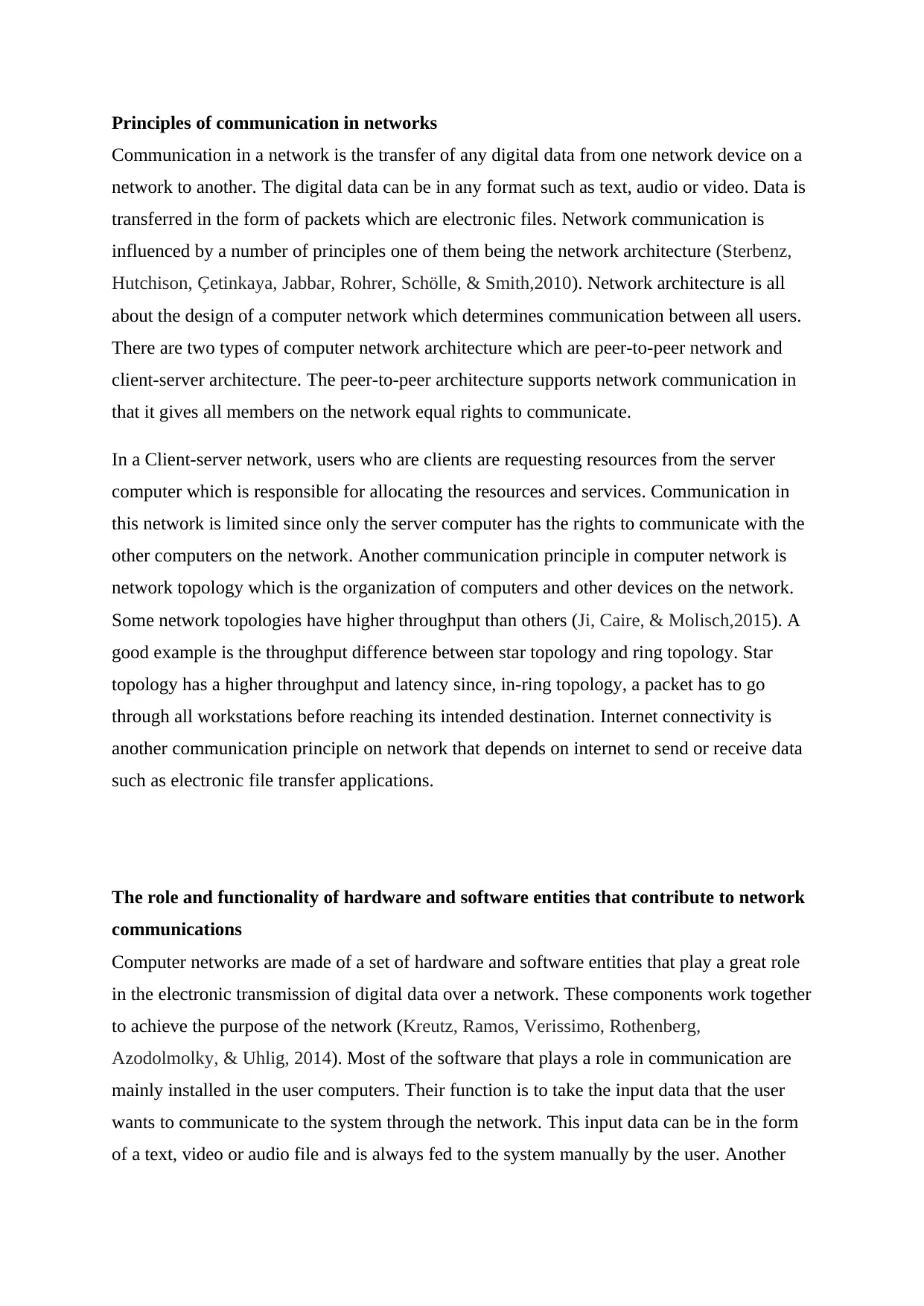
Principles of communication in networks
Communication in a network is the transfer of any digital data from one network device on a
network to another. The digital data can be in any format such as text, audio or video. Data is
transferred in the form of packets which are electronic files. Network communication is
influenced by a number of principles one of them being the network architecture (Sterbenz,
Hutchison, Çetinkaya, Jabbar, Rohrer, Schölle, & Smith,2010). Network architecture is all
about the design of a computer network which determines communication between all users.
There are two types of computer network architecture which are peer-to-peer network and
client-server architecture. The peer-to-peer architecture supports network communication in
that it gives all members on the network equal rights to communicate.
In a Client-server network, users who are clients are requesting resources from the server
computer which is responsible for allocating the resources and services. Communication in
this network is limited since only the server computer has the rights to communicate with the
other computers on the network. Another communication principle in computer network is
network topology which is the organization of computers and other devices on the network.
Some network topologies have higher throughput than others (Ji, Caire, & Molisch,2015). A
good example is the throughput difference between star topology and ring topology. Star
topology has a higher throughput and latency since, in-ring topology, a packet has to go
through all workstations before reaching its intended destination. Internet connectivity is
another communication principle on network that depends on internet to send or receive data
such as electronic file transfer applications.
The role and functionality of hardware and software entities that contribute to network
communications
Computer networks are made of a set of hardware and software entities that play a great role
in the electronic transmission of digital data over a network. These components work together
to achieve the purpose of the network (Kreutz, Ramos, Verissimo, Rothenberg,
Azodolmolky, & Uhlig, 2014). Most of the software that plays a role in communication are
mainly installed in the user computers. Their function is to take the input data that the user
wants to communicate to the system through the network. This input data can be in the form
of a text, video or audio file and is always fed to the system manually by the user. Another
Communication in a network is the transfer of any digital data from one network device on a
network to another. The digital data can be in any format such as text, audio or video. Data is
transferred in the form of packets which are electronic files. Network communication is
influenced by a number of principles one of them being the network architecture (Sterbenz,
Hutchison, Çetinkaya, Jabbar, Rohrer, Schölle, & Smith,2010). Network architecture is all
about the design of a computer network which determines communication between all users.
There are two types of computer network architecture which are peer-to-peer network and
client-server architecture. The peer-to-peer architecture supports network communication in
that it gives all members on the network equal rights to communicate.
In a Client-server network, users who are clients are requesting resources from the server
computer which is responsible for allocating the resources and services. Communication in
this network is limited since only the server computer has the rights to communicate with the
other computers on the network. Another communication principle in computer network is
network topology which is the organization of computers and other devices on the network.
Some network topologies have higher throughput than others (Ji, Caire, & Molisch,2015). A
good example is the throughput difference between star topology and ring topology. Star
topology has a higher throughput and latency since, in-ring topology, a packet has to go
through all workstations before reaching its intended destination. Internet connectivity is
another communication principle on network that depends on internet to send or receive data
such as electronic file transfer applications.
The role and functionality of hardware and software entities that contribute to network
communications
Computer networks are made of a set of hardware and software entities that play a great role
in the electronic transmission of digital data over a network. These components work together
to achieve the purpose of the network (Kreutz, Ramos, Verissimo, Rothenberg,
Azodolmolky, & Uhlig, 2014). Most of the software that plays a role in communication are
mainly installed in the user computers. Their function is to take the input data that the user
wants to communicate to the system through the network. This input data can be in the form
of a text, video or audio file and is always fed to the system manually by the user. Another
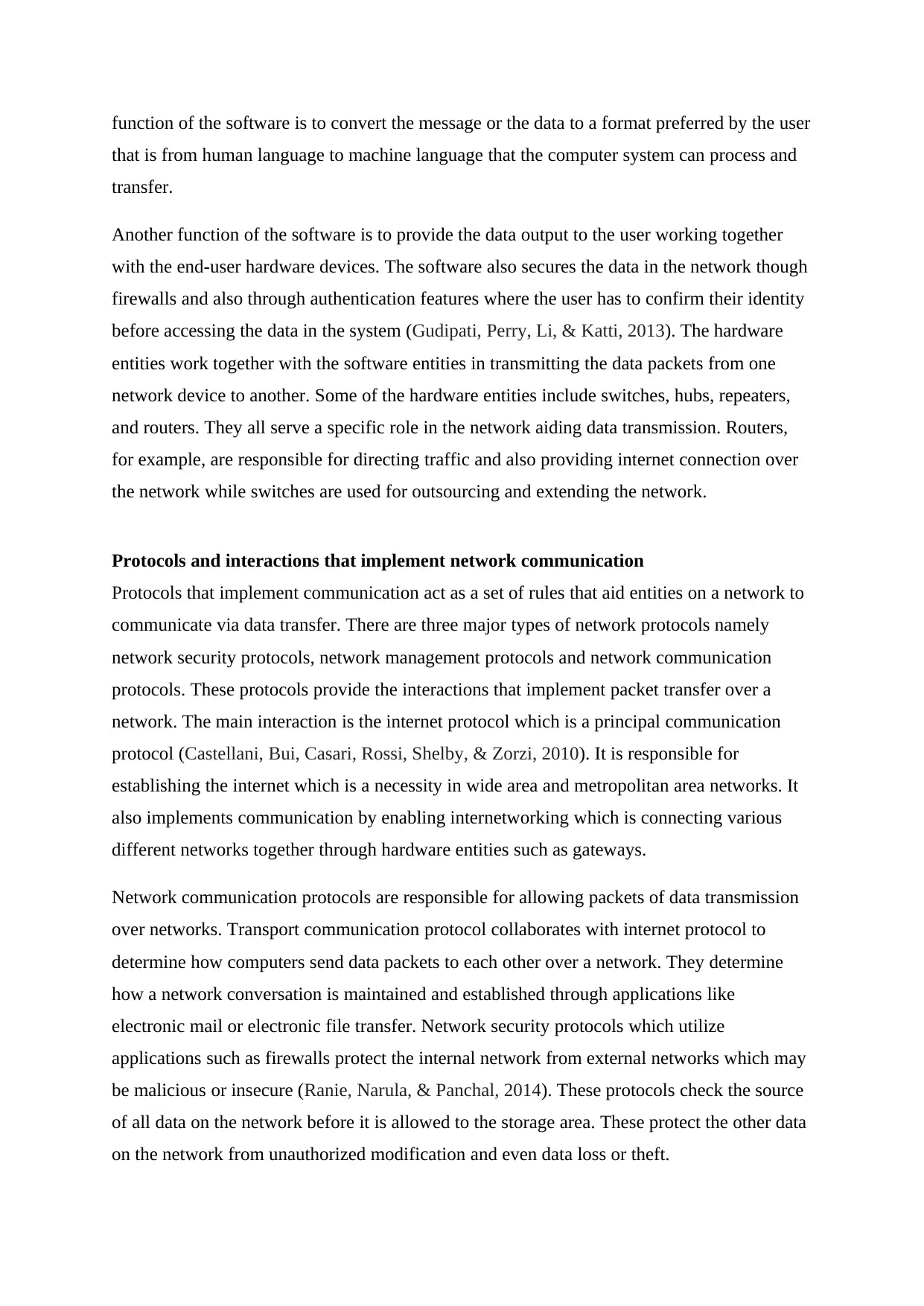
function of the software is to convert the message or the data to a format preferred by the user
that is from human language to machine language that the computer system can process and
transfer.
Another function of the software is to provide the data output to the user working together
with the end-user hardware devices. The software also secures the data in the network though
firewalls and also through authentication features where the user has to confirm their identity
before accessing the data in the system (Gudipati, Perry, Li, & Katti, 2013). The hardware
entities work together with the software entities in transmitting the data packets from one
network device to another. Some of the hardware entities include switches, hubs, repeaters,
and routers. They all serve a specific role in the network aiding data transmission. Routers,
for example, are responsible for directing traffic and also providing internet connection over
the network while switches are used for outsourcing and extending the network.
Protocols and interactions that implement network communication
Protocols that implement communication act as a set of rules that aid entities on a network to
communicate via data transfer. There are three major types of network protocols namely
network security protocols, network management protocols and network communication
protocols. These protocols provide the interactions that implement packet transfer over a
network. The main interaction is the internet protocol which is a principal communication
protocol (Castellani, Bui, Casari, Rossi, Shelby, & Zorzi, 2010). It is responsible for
establishing the internet which is a necessity in wide area and metropolitan area networks. It
also implements communication by enabling internetworking which is connecting various
different networks together through hardware entities such as gateways.
Network communication protocols are responsible for allowing packets of data transmission
over networks. Transport communication protocol collaborates with internet protocol to
determine how computers send data packets to each other over a network. They determine
how a network conversation is maintained and established through applications like
electronic mail or electronic file transfer. Network security protocols which utilize
applications such as firewalls protect the internal network from external networks which may
be malicious or insecure (Ranie, Narula, & Panchal, 2014). These protocols check the source
of all data on the network before it is allowed to the storage area. These protect the other data
on the network from unauthorized modification and even data loss or theft.
that is from human language to machine language that the computer system can process and
transfer.
Another function of the software is to provide the data output to the user working together
with the end-user hardware devices. The software also secures the data in the network though
firewalls and also through authentication features where the user has to confirm their identity
before accessing the data in the system (Gudipati, Perry, Li, & Katti, 2013). The hardware
entities work together with the software entities in transmitting the data packets from one
network device to another. Some of the hardware entities include switches, hubs, repeaters,
and routers. They all serve a specific role in the network aiding data transmission. Routers,
for example, are responsible for directing traffic and also providing internet connection over
the network while switches are used for outsourcing and extending the network.
Protocols and interactions that implement network communication
Protocols that implement communication act as a set of rules that aid entities on a network to
communicate via data transfer. There are three major types of network protocols namely
network security protocols, network management protocols and network communication
protocols. These protocols provide the interactions that implement packet transfer over a
network. The main interaction is the internet protocol which is a principal communication
protocol (Castellani, Bui, Casari, Rossi, Shelby, & Zorzi, 2010). It is responsible for
establishing the internet which is a necessity in wide area and metropolitan area networks. It
also implements communication by enabling internetworking which is connecting various
different networks together through hardware entities such as gateways.
Network communication protocols are responsible for allowing packets of data transmission
over networks. Transport communication protocol collaborates with internet protocol to
determine how computers send data packets to each other over a network. They determine
how a network conversation is maintained and established through applications like
electronic mail or electronic file transfer. Network security protocols which utilize
applications such as firewalls protect the internal network from external networks which may
be malicious or insecure (Ranie, Narula, & Panchal, 2014). These protocols check the source
of all data on the network before it is allowed to the storage area. These protect the other data
on the network from unauthorized modification and even data loss or theft.
⊘ This is a preview!⊘
Do you want full access?
Subscribe today to unlock all pages.

Trusted by 1+ million students worldwide
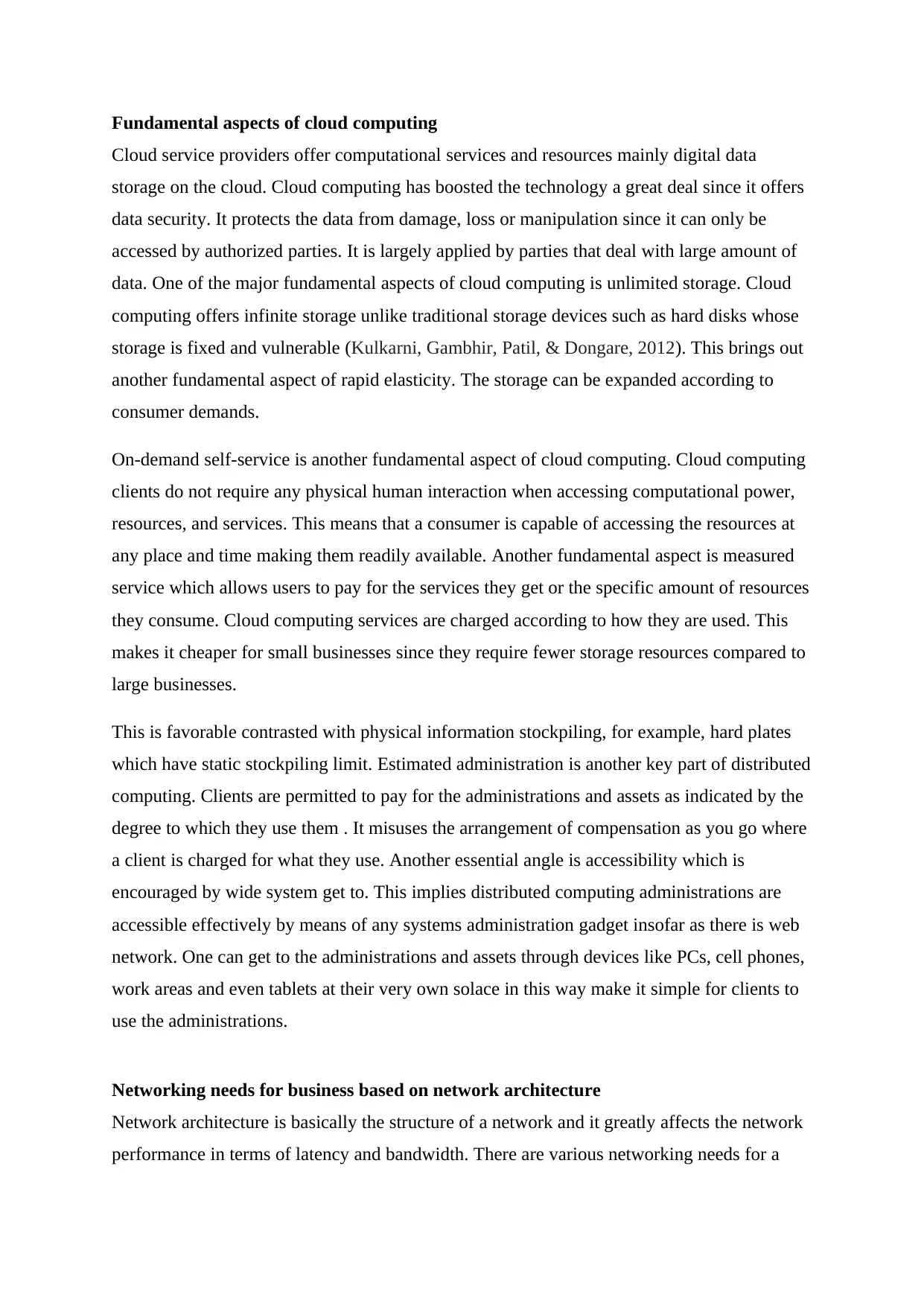
Fundamental aspects of cloud computing
Cloud service providers offer computational services and resources mainly digital data
storage on the cloud. Cloud computing has boosted the technology a great deal since it offers
data security. It protects the data from damage, loss or manipulation since it can only be
accessed by authorized parties. It is largely applied by parties that deal with large amount of
data. One of the major fundamental aspects of cloud computing is unlimited storage. Cloud
computing offers infinite storage unlike traditional storage devices such as hard disks whose
storage is fixed and vulnerable (Kulkarni, Gambhir, Patil, & Dongare, 2012). This brings out
another fundamental aspect of rapid elasticity. The storage can be expanded according to
consumer demands.
On-demand self-service is another fundamental aspect of cloud computing. Cloud computing
clients do not require any physical human interaction when accessing computational power,
resources, and services. This means that a consumer is capable of accessing the resources at
any place and time making them readily available. Another fundamental aspect is measured
service which allows users to pay for the services they get or the specific amount of resources
they consume. Cloud computing services are charged according to how they are used. This
makes it cheaper for small businesses since they require fewer storage resources compared to
large businesses.
This is favorable contrasted with physical information stockpiling, for example, hard plates
which have static stockpiling limit. Estimated administration is another key part of distributed
computing. Clients are permitted to pay for the administrations and assets as indicated by the
degree to which they use them . It misuses the arrangement of compensation as you go where
a client is charged for what they use. Another essential angle is accessibility which is
encouraged by wide system get to. This implies distributed computing administrations are
accessible effectively by means of any systems administration gadget insofar as there is web
network. One can get to the administrations and assets through devices like PCs, cell phones,
work areas and even tablets at their very own solace in this way make it simple for clients to
use the administrations.
Networking needs for business based on network architecture
Network architecture is basically the structure of a network and it greatly affects the network
performance in terms of latency and bandwidth. There are various networking needs for a
Cloud service providers offer computational services and resources mainly digital data
storage on the cloud. Cloud computing has boosted the technology a great deal since it offers
data security. It protects the data from damage, loss or manipulation since it can only be
accessed by authorized parties. It is largely applied by parties that deal with large amount of
data. One of the major fundamental aspects of cloud computing is unlimited storage. Cloud
computing offers infinite storage unlike traditional storage devices such as hard disks whose
storage is fixed and vulnerable (Kulkarni, Gambhir, Patil, & Dongare, 2012). This brings out
another fundamental aspect of rapid elasticity. The storage can be expanded according to
consumer demands.
On-demand self-service is another fundamental aspect of cloud computing. Cloud computing
clients do not require any physical human interaction when accessing computational power,
resources, and services. This means that a consumer is capable of accessing the resources at
any place and time making them readily available. Another fundamental aspect is measured
service which allows users to pay for the services they get or the specific amount of resources
they consume. Cloud computing services are charged according to how they are used. This
makes it cheaper for small businesses since they require fewer storage resources compared to
large businesses.
This is favorable contrasted with physical information stockpiling, for example, hard plates
which have static stockpiling limit. Estimated administration is another key part of distributed
computing. Clients are permitted to pay for the administrations and assets as indicated by the
degree to which they use them . It misuses the arrangement of compensation as you go where
a client is charged for what they use. Another essential angle is accessibility which is
encouraged by wide system get to. This implies distributed computing administrations are
accessible effectively by means of any systems administration gadget insofar as there is web
network. One can get to the administrations and assets through devices like PCs, cell phones,
work areas and even tablets at their very own solace in this way make it simple for clients to
use the administrations.
Networking needs for business based on network architecture
Network architecture is basically the structure of a network and it greatly affects the network
performance in terms of latency and bandwidth. There are various networking needs for a
Paraphrase This Document
Need a fresh take? Get an instant paraphrase of this document with our AI Paraphraser
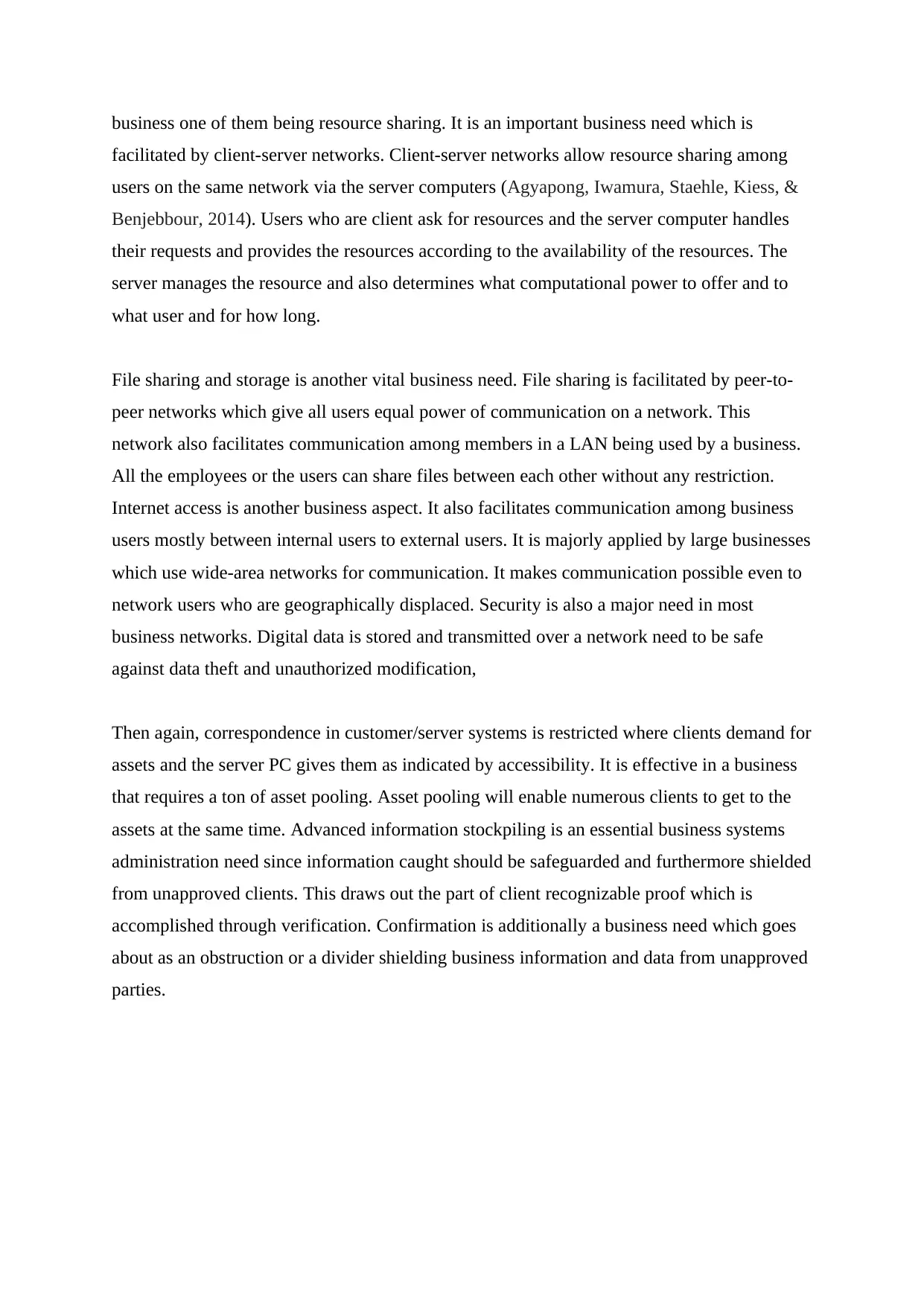
business one of them being resource sharing. It is an important business need which is
facilitated by client-server networks. Client-server networks allow resource sharing among
users on the same network via the server computers (Agyapong, Iwamura, Staehle, Kiess, &
Benjebbour, 2014). Users who are client ask for resources and the server computer handles
their requests and provides the resources according to the availability of the resources. The
server manages the resource and also determines what computational power to offer and to
what user and for how long.
File sharing and storage is another vital business need. File sharing is facilitated by peer-to-
peer networks which give all users equal power of communication on a network. This
network also facilitates communication among members in a LAN being used by a business.
All the employees or the users can share files between each other without any restriction.
Internet access is another business aspect. It also facilitates communication among business
users mostly between internal users to external users. It is majorly applied by large businesses
which use wide-area networks for communication. It makes communication possible even to
network users who are geographically displaced. Security is also a major need in most
business networks. Digital data is stored and transmitted over a network need to be safe
against data theft and unauthorized modification,
Then again, correspondence in customer/server systems is restricted where clients demand for
assets and the server PC gives them as indicated by accessibility. It is effective in a business
that requires a ton of asset pooling. Asset pooling will enable numerous clients to get to the
assets at the same time. Advanced information stockpiling is an essential business systems
administration need since information caught should be safeguarded and furthermore shielded
from unapproved clients. This draws out the part of client recognizable proof which is
accomplished through verification. Confirmation is additionally a business need which goes
about as an obstruction or a divider shielding business information and data from unapproved
parties.
facilitated by client-server networks. Client-server networks allow resource sharing among
users on the same network via the server computers (Agyapong, Iwamura, Staehle, Kiess, &
Benjebbour, 2014). Users who are client ask for resources and the server computer handles
their requests and provides the resources according to the availability of the resources. The
server manages the resource and also determines what computational power to offer and to
what user and for how long.
File sharing and storage is another vital business need. File sharing is facilitated by peer-to-
peer networks which give all users equal power of communication on a network. This
network also facilitates communication among members in a LAN being used by a business.
All the employees or the users can share files between each other without any restriction.
Internet access is another business aspect. It also facilitates communication among business
users mostly between internal users to external users. It is majorly applied by large businesses
which use wide-area networks for communication. It makes communication possible even to
network users who are geographically displaced. Security is also a major need in most
business networks. Digital data is stored and transmitted over a network need to be safe
against data theft and unauthorized modification,
Then again, correspondence in customer/server systems is restricted where clients demand for
assets and the server PC gives them as indicated by accessibility. It is effective in a business
that requires a ton of asset pooling. Asset pooling will enable numerous clients to get to the
assets at the same time. Advanced information stockpiling is an essential business systems
administration need since information caught should be safeguarded and furthermore shielded
from unapproved clients. This draws out the part of client recognizable proof which is
accomplished through verification. Confirmation is additionally a business need which goes
about as an obstruction or a divider shielding business information and data from unapproved
parties.
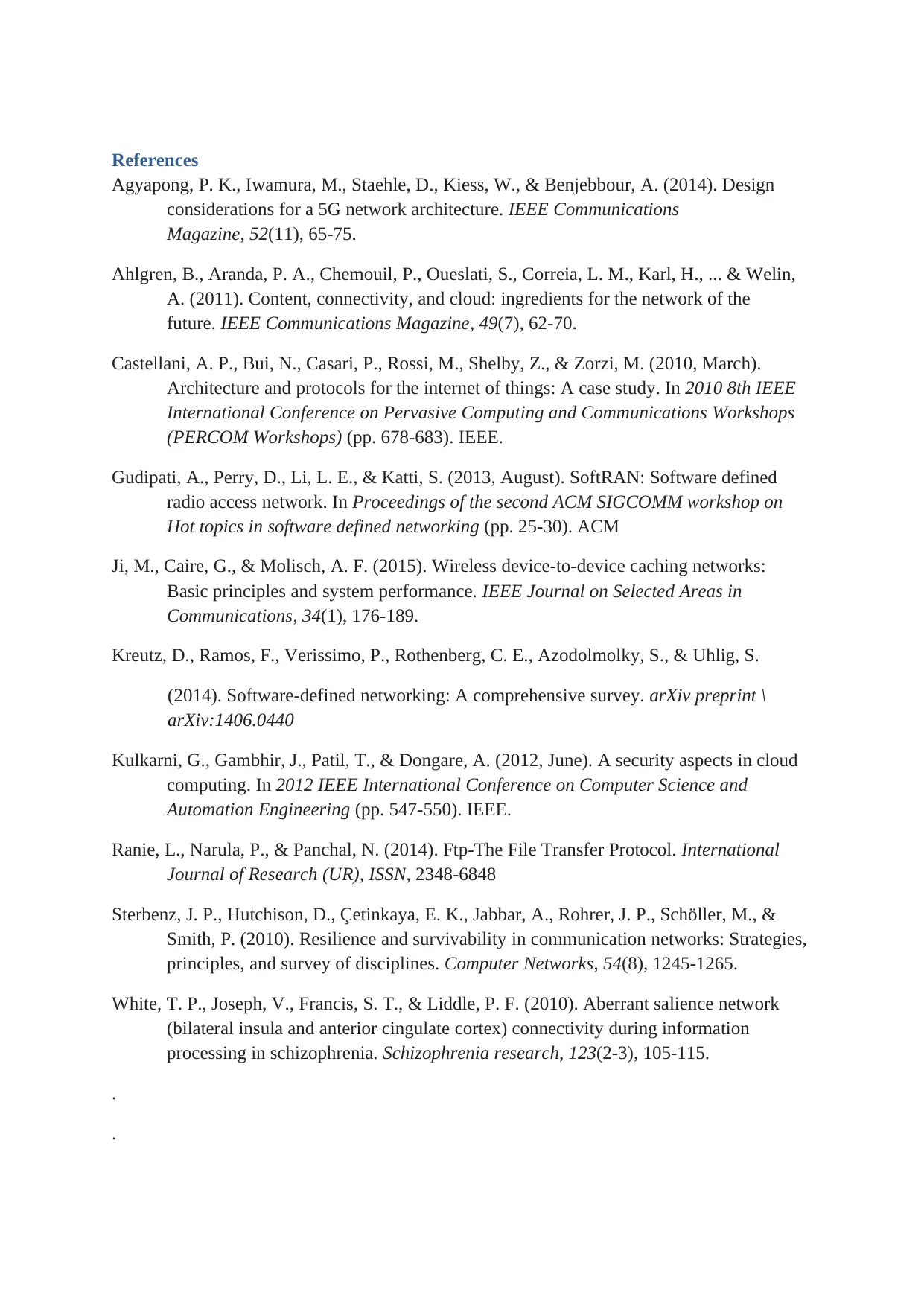
References
Agyapong, P. K., Iwamura, M., Staehle, D., Kiess, W., & Benjebbour, A. (2014). Design
considerations for a 5G network architecture. IEEE Communications
Magazine, 52(11), 65-75.
Ahlgren, B., Aranda, P. A., Chemouil, P., Oueslati, S., Correia, L. M., Karl, H., ... & Welin,
A. (2011). Content, connectivity, and cloud: ingredients for the network of the
future. IEEE Communications Magazine, 49(7), 62-70.
Castellani, A. P., Bui, N., Casari, P., Rossi, M., Shelby, Z., & Zorzi, M. (2010, March).
Architecture and protocols for the internet of things: A case study. In 2010 8th IEEE
International Conference on Pervasive Computing and Communications Workshops
(PERCOM Workshops) (pp. 678-683). IEEE.
Gudipati, A., Perry, D., Li, L. E., & Katti, S. (2013, August). SoftRAN: Software defined
radio access network. In Proceedings of the second ACM SIGCOMM workshop on
Hot topics in software defined networking (pp. 25-30). ACM
Ji, M., Caire, G., & Molisch, A. F. (2015). Wireless device-to-device caching networks:
Basic principles and system performance. IEEE Journal on Selected Areas in
Communications, 34(1), 176-189.
Kreutz, D., Ramos, F., Verissimo, P., Rothenberg, C. E., Azodolmolky, S., & Uhlig, S.
(2014). Software-defined networking: A comprehensive survey. arXiv preprint \
arXiv:1406.0440
Kulkarni, G., Gambhir, J., Patil, T., & Dongare, A. (2012, June). A security aspects in cloud
computing. In 2012 IEEE International Conference on Computer Science and
Automation Engineering (pp. 547-550). IEEE.
Ranie, L., Narula, P., & Panchal, N. (2014). Ftp-The File Transfer Protocol. International
Journal of Research (UR), ISSN, 2348-6848
Sterbenz, J. P., Hutchison, D., Çetinkaya, E. K., Jabbar, A., Rohrer, J. P., Schöller, M., &
Smith, P. (2010). Resilience and survivability in communication networks: Strategies,
principles, and survey of disciplines. Computer Networks, 54(8), 1245-1265.
White, T. P., Joseph, V., Francis, S. T., & Liddle, P. F. (2010). Aberrant salience network
(bilateral insula and anterior cingulate cortex) connectivity during information
processing in schizophrenia. Schizophrenia research, 123(2-3), 105-115.
.
.
Agyapong, P. K., Iwamura, M., Staehle, D., Kiess, W., & Benjebbour, A. (2014). Design
considerations for a 5G network architecture. IEEE Communications
Magazine, 52(11), 65-75.
Ahlgren, B., Aranda, P. A., Chemouil, P., Oueslati, S., Correia, L. M., Karl, H., ... & Welin,
A. (2011). Content, connectivity, and cloud: ingredients for the network of the
future. IEEE Communications Magazine, 49(7), 62-70.
Castellani, A. P., Bui, N., Casari, P., Rossi, M., Shelby, Z., & Zorzi, M. (2010, March).
Architecture and protocols for the internet of things: A case study. In 2010 8th IEEE
International Conference on Pervasive Computing and Communications Workshops
(PERCOM Workshops) (pp. 678-683). IEEE.
Gudipati, A., Perry, D., Li, L. E., & Katti, S. (2013, August). SoftRAN: Software defined
radio access network. In Proceedings of the second ACM SIGCOMM workshop on
Hot topics in software defined networking (pp. 25-30). ACM
Ji, M., Caire, G., & Molisch, A. F. (2015). Wireless device-to-device caching networks:
Basic principles and system performance. IEEE Journal on Selected Areas in
Communications, 34(1), 176-189.
Kreutz, D., Ramos, F., Verissimo, P., Rothenberg, C. E., Azodolmolky, S., & Uhlig, S.
(2014). Software-defined networking: A comprehensive survey. arXiv preprint \
arXiv:1406.0440
Kulkarni, G., Gambhir, J., Patil, T., & Dongare, A. (2012, June). A security aspects in cloud
computing. In 2012 IEEE International Conference on Computer Science and
Automation Engineering (pp. 547-550). IEEE.
Ranie, L., Narula, P., & Panchal, N. (2014). Ftp-The File Transfer Protocol. International
Journal of Research (UR), ISSN, 2348-6848
Sterbenz, J. P., Hutchison, D., Çetinkaya, E. K., Jabbar, A., Rohrer, J. P., Schöller, M., &
Smith, P. (2010). Resilience and survivability in communication networks: Strategies,
principles, and survey of disciplines. Computer Networks, 54(8), 1245-1265.
White, T. P., Joseph, V., Francis, S. T., & Liddle, P. F. (2010). Aberrant salience network
(bilateral insula and anterior cingulate cortex) connectivity during information
processing in schizophrenia. Schizophrenia research, 123(2-3), 105-115.
.
.
⊘ This is a preview!⊘
Do you want full access?
Subscribe today to unlock all pages.

Trusted by 1+ million students worldwide

1 out of 10
Related Documents
Your All-in-One AI-Powered Toolkit for Academic Success.
+13062052269
info@desklib.com
Available 24*7 on WhatsApp / Email
![[object Object]](/_next/static/media/star-bottom.7253800d.svg)
Unlock your academic potential
Copyright © 2020–2025 A2Z Services. All Rights Reserved. Developed and managed by ZUCOL.





